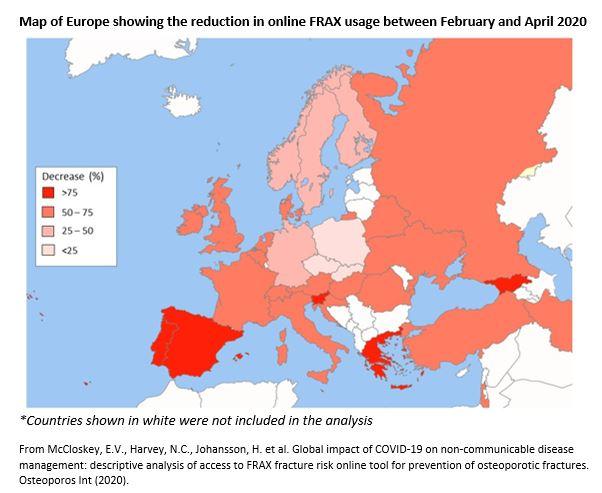A new study published prior to World Osteoporosis Day finds that the COVID-19 pandemic, which has severely affected management of non-communicable diseases, is markedly impacting the management of osteoporosis as judged by access to online FRAX fracture risk assessments.1,2
Globally, usage of the Fracture Risk Assessment Tool (FRAX®) website was on average 58% lower in April than in February 2020.
FRAX is used to generate 10-year probabilities of fracture at the hip or major skeletal sites using clinical risk factors, with or without bone mineral density (BMD) values. FRAX calculators are available for 66 countries, representing well over 80% of the global population, and the tool is accessed by at least 228 countries/territories worldwide. Widely adopted within clinical guidelines for osteoporosis, FRAX is a key component in the initiation of targeted treatment to reduce the future burden of fractures.
Lead author, Professor Eugene McCloskey, Professor in Adult Bone Disease at the Department of Oncology and Metabolism, University of Sheffield, UK, stated: “As a global tool the FRAX website provides an excellent opportunity to explore the impact of the COVID-19 pandemic on osteoporosis, a major non-communicable disease (NCD) with a significant impact on older adults worldwide.”
“The findings of this study reveal that, since the pandemic was officially declared by the WHO on March 11, there has been a dramatic drop in FRAX usage, averaging 58% but ranging up to 96%, with two-thirds of the 66 countries/territories evaluated showing reductions by at least 50%.”
The analysis of FRAX usage showed:
- Over February-April 2020, the FRAX website recorded 460,495 sessions from 184 countries, with 210,656 sessions in February alone.
- In March and April, the number of sessions fell by 23.1% and 58.3% respectively, compared to February 2020, a pattern not observed over the same period in 2019.
- In Europe, the majority of countries (24/31, 77.4%) reduced usage by at least 50% in April, with Poland, Slovakia, Czech Republic, Germany, Norway, Sweden and Finland showing smaller reductions (range -2.85% to -44.1%).
- In Latin America, all eight countries studied showed reductions greater than 50%, with the smallest reduction seen in Brazil (-54.5%) and the greatest seen in Ecuador (-76.9%).
- There were smaller reductions in Asia than elsewhere, partly related to earlier and less-marked nadirs in some countries (China, Taiwan, Hong Kong, South Korea and Vietnam).
- There was no significant relationship between the reduction in FRAX usage and measures of disease burden such as COVID-attributed deaths per million of the population.
Metrics of FRAX usage captured by GoogleAnalytics (sessions rather than individual calculations) underestimate actual usage by about 30%, and additionally many FRAX assessments worldwide are conducted on bone densitometers, and were therefore not captured in the study.
As a result, it is estimated that approximately 175,000 patients were likely excluded from fracture risk assessment in April 2020, suggesting that over a 3-month period more than 0.5 million patients would be excluded from assessment, and a significant portion of those from necessary treatment.
Professor John Kanis, IOF Honorary President, Director of the Centre for Metabolic Bone Diseases at Sheffield and Professor at the Catholic University of Australia, stated: “The drastic reduction in FRAX usage underscores widespread concern that the COVID-19 pandemic is having a detrimental impact on the medium to long-term management and outcomes for many NCDs, with serious repercussions for individuals who are not able to access timely testing and treatment, including for osteoporosis.”
“Availability and access to bone densitometry in many countries is low to begin with, and access to secondary care-based facilities such as Fracture Liaison Services has been further comprised or inhibited completely during the pandemic. We expect that FRAX, which can be undertaken remotely via telemedicine and has been shown to have a predictive value for fractures that is comparable to the use of bone density values alone, may be able to play a significant role in addressing this enormous backlog in assessments for osteoporosis.”
###
References
1. McCloskey, E.V., Harvey, N.C., Johansson, H. et al. Global impact of COVID-19 on non-communicable disease management: descriptive analysis of access to FRAX fracture risk online tool for prevention of osteoporotic fractures. Osteoporos Int (2020). https:/
2. FRAX Fracture Risk Assessment Tool https:/
About FRAX
FRAX® is a simple calculation tool that integrates clinical information in a quantitative manner to predict a 10-year probability of major osteoporotic fracture for both women and men in different countries. The tool was developed at the Centre for Metabolic Bone Diseases, University of Sheffield, UK in collaboration with international researchers. It assists primary health-care providers to better target people in need of interventions to reduce fracture risk, thus improving the allocation of health-care resources towards patients most likely to benefit from treatment. The FRAX calculator, freely available for use online, is available for 66 countries and in 34 languages. It is the most widely used risk assessment tool, incorporated into national and regional guidelines worldwide. https:/
About IOF
The International Osteoporosis Foundation (IOF) is the world’s largest nongovernmental organization dedicated to the prevention, diagnosis and treatment of osteoporosis and related musculoskeletal diseases. IOF members, including committees of scientific researchers as well as 260 patient, medical and research societies, work together to make fracture prevention and healthy mobility a worldwide heath care priority. https:/
About World Osteoporosis Day
World Osteoporosis Day (WOD) is held annually on October 20th. The campaign calls for global action to fight osteoporosis and related fractures. http://www.
